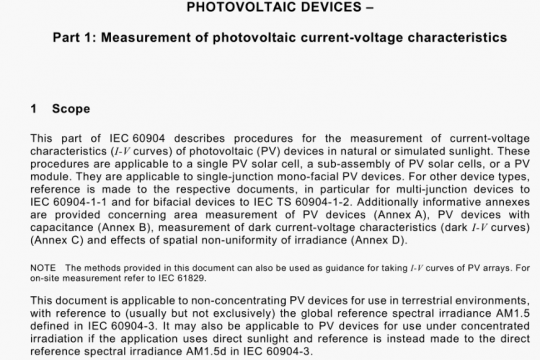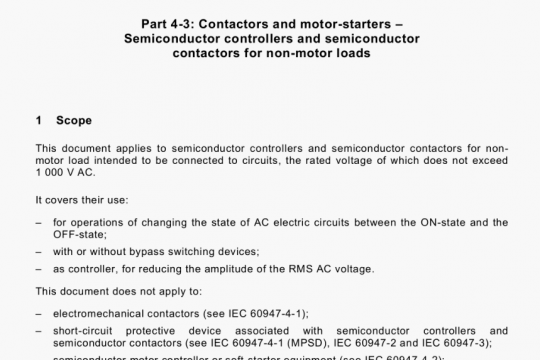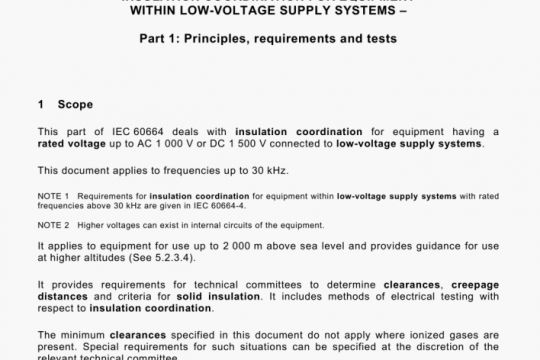IEC TS 60034-27-5-2021 pdf free
IEC TS 60034-27-5-2021 pdf free.Rotating electrical machines – Part 27-5: Off-line measurement of partial discharge inception voltage on winding insulation under repetitive impulse voltage.
For the purposes of this document, the terms, definitions, symbols and abbreviated terms given in IEC 60034-27-1, IEC TS 61934, and the following apply.
ISO and IEC maintain terminological databases for use in standardization at the following
addresses:
• IEC Electropedia: available at http:/Iwww.electropedia.org/
• ISO Online browsing platform: available at http://www.iso.org/obp
partial discharge PD localized electrical discharge that only partially bridges the insulation between conductors and which can or cannot occur adjacent to a conductor
repetitive partial discharge inception voltage RPDIV
minimum peak-to-peak impulse voltage at which more than five PD pulses occur on ten voltage impulses of the same peak-to-peak values when the impulse voltage applied to the test object is increased with step-by-step method.
This document describes RPDIV and RPDEV as repetitive partial discharge inception and extinction voltage of test objects under repetitive impulse voltage. They were first defined in IEC TS 61934 and are redefined in this document. Both RPDIV and RPDEV have two features compared with the conventional PDIV and PDEV under sinusoidal voltage defined in IEC 60034- 27-1. The first feature is the clear definition of repetitive impulse voltage with distortion and the second one is 50 % PD occurrence probability.
Figure 1 shows a representative scheme of a measurement circuit for RPDIV and RPDEV as a block diagram. Repetitive impulse voltage from an impulse generator (IG) are mentioned in detail in this Clause 4. PD measuring methods” are’ mentioned in Clause 5. Subclause 6.1 todosoribesntest objects of both model samples and complete windings. A four-terminal test object is illustrated in Figure 1 as a complete winding of a three-phase rotating machine with a neutral point terminal. The combination of the possible connections is summarized in Table 2 and Table 3 and in Annex C. PD behaviour reflects the internal voltage inside the winding of the test object mentioned in 4,5. The relation between terminal voltage and internal voltage distribution depends mainly on rise time r For the detection of PD on turn-turn insulation, a short 1r is preferable, as rise time t, is influenced not only by output from the 1G. but also by whole circuit parameters. The detail is discussed in 4.5.
This Clause 4 starts with the waveforms of single impulse voltage at the open terminals of two types of impulse generator: a conventional IG circuit with one switch, and a four-arm (H type) bridge circuit, like a converter itself as mentioned in 4.2.1. The output waveform of the IGs looks like a triangular or rectangular impulse, respectively.
The impulse voltage waveforms are distorted due to test objects with capacitive, inductive and resistive impedance. The distortion can occur through attenuation and dispersion, but also as a result of reflection, resonance and cross-coupling phenomena. Three typical distortions of single impulse waveform are discussed in 4.2.2. Next is the introduction of a “train of impulse” which characterizes the repetition of a single impulse as mentioned in 4.3. Finally, the step-by- step (SBS) increase and decrease of the train of repetitive impulses is mentioned in 4.4. Many different types of impulse waveforms are presented in Clause 4. In practice the impulse generators (IG) producing waveforms in Figure 12 and Figure 16 are the most common.
4.2 Waveform of single impulse voltage
4.2.1 Waveform at impulse generator terminal without test object
The waveform of a single impulse depends on the impulse generator and the test circuit conditions. Impulse generators (IG) used in this document may be classified into two types of circuit.
The first type of IG consists of capacitor C, switch S and an output impedance, resistance R and inductance L as shown in Figure 2. The left-hand side is a charging circuit and the right- hand side is an output terminal. It is noted that the capacitor is regarded as a current source for transient phenomena rather than being a voltage source. Historically, gap discharge between metal electrodes with a trigger was utilized for a long time as switch S. Today, however, high voltage power devices are commonly used as the switch, such as a thyristor, MOSFET, IGBT. When switch S is closed after charging the capacitor C, a triangular unipolar impulse appears at open terminals of the impulse generator as shown In Figure 3. The rise time r,. depends mainly on switching characteristics of the power device and resistance of the test object in series. The decay time d depends on resistance R. Without a load or test object, td is longer than r,. and terminal voltage appears step-like. With a test object, d becomes shorter, and impulse becomes a familiar triangular waveform. The waveform becomes a unipolar impulse with the same polarity as the capacitor. If impulses with both positive and negative polarity are needed for bipolar waveforms, a cascade of the circuit in Figure 2 and the additional switch circuit for polarity change may be necessary.IEC TS 60034-27-5 pdf download.




